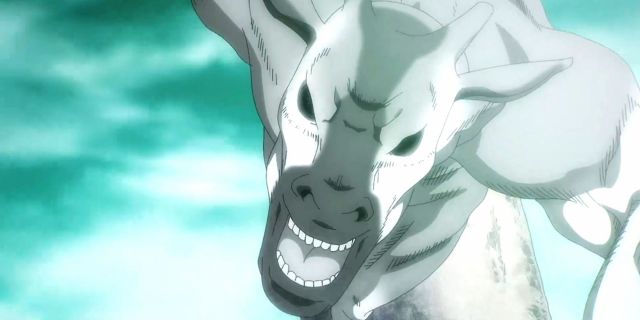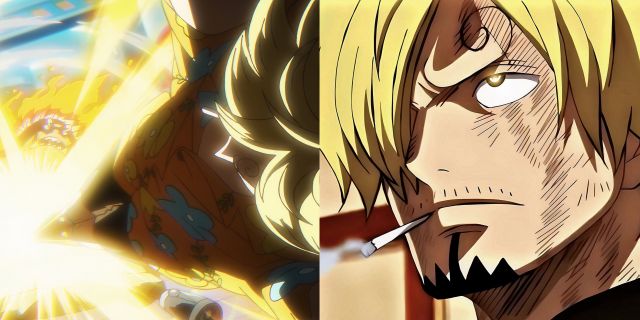Highlights
- The Okapi Titan, resembling the rare forest giraffe, played a pivotal role in the final battle and threatened the alliance.
- It was likely a past wielder of the Beast Titan, possessing abnormal appearance and abilities.
- The origins of the Okapi Titan remain unclear, but its inclusion added excitement and intrigue to the story of the Titans.
In the climactic final battle atop the Founding Titan, Eren Yeager’s spirit ally Ymir Fritz utilizes the powers of the Nine Titans to resurrect past holders in an effort to stop the alliance formed against the Rumbling. Among the titans summoned from ages past was one that stood out from the rest in its unique appearance: the Okapi Titan.
This Titan surprised viewers with its resemblance to the rare forest giraffe known as an okapi, a mammal native to the Congo Rainforest. Standing on all fours yet capable of great speed, the Okapi Titan was smaller than others but proved to be a dangerous force. But what is known about the Okapi Titan and its significance in the larger story?
The True Nature and Appearance of the Okapi Titan

As its name suggests, the Okapi Titan shares many physical traits with the rare forest-dwelling Okapi. It has an elongated, triangular-shaped head with long ears that stand upright and small eyes located more on the sides of the head. The Titan’s most distinctive trait is its head, which is identical to that of an Okapi. Its body shape is similar to that of a normal Titan. When transformed, it appeared to stand around four meters tall on all fours. Not much is known about its abilities, though it seemed fairly small and quick based on being able to elude Mikasa, Connie, and Annie during its brief appearance.
More insight into the Okapi Titan is gleaned from context clues within the story. It is understood to be a former inheritor of one of the Nine Titans from ancient times, resurrected by Ymir Fritz to fight against the alliance. Specifically, most believe it was a past wielder of the extremely powerful Beast Titan, known for its ability to transform the user into various animal forms. This would explain the Okapi Titan’s abnormal appearance. Some theories even speculate it was originally a Cart Titan who gained Beast Titan abilities through serum enhancing its physical traits. Regardless of its origins, it was clearly an exceptionally rare and dangerous Titan from ages past.
The Okapi Titan’s Role in the Finale

Its role in the conclusion of the story was a pivotal one. With the fate of the world hanging in the balance atop the Founding Titan, the Okapi Titan was deployed by Ymir Fritz to kidnap Armin Arlert, the current user of the Colossal Titan. This was likely a strategic move, as preventing Armin from transforming and using the Colossal’s powerful abilities would seriously hamper the alliance’s efforts. In snatching Armin away unexpectedly, the Titan forced Mikasa and others into a desperate chase that split their attention away from combating other resurrected Titans.
This tense chase sequence showed off the Okapi Titan’s stealth and speed, which far surpassed the alliance members on foot. It was only thanks to outside assistance that Mikasa was finally able to catch up—through Gabi Braun shooting its nape from Falco Grice’s newly obtained flying Jaw Titan. Even after being wounded, the Okapi Titan resorted to violently impaling Armin’s leg with its tongue before meeting its end. Without a doubt, it was a highly dangerous foe whose actions created a crisis that threatened the fate of the world. Its unique traits as the Okapi Titan made for a thrilling new addition to the climactic finale.
The Mystery Behind its Origins

Despite playing a major role, many unanswered questions still surround the mysterious Okapi Titan. Chiefly, its exact origins and relation to the Nine Titans of old are ambiguous. The general theory is that it was a previous inheritor of the notoriously savage Beast Titan, which would account for its unusual animal traits. Yet it’s possible it was originally a Cart Titan accidentally infused with Beast Titan abilities through serum. Regrettably, no concrete facts are given about this specific Titan shifter’s identity, when they lived, or what role they played during the ancient Eldian Empire era.
All that can be said for sure is that this unique Titan was put to effective use by Ymir Fritz in the endgame battle. Even long after this individual Titan shifter’s presumed death per the 13-year curse, the Okapi Titan’s powers remained intact enough to be summoned and posed a serious threat. It raises fascinating questions about how different the Nine Titans may have appeared throughout history as they passed down from one inheritor to another over centuries. For devoted Attack on Titan fans, pondering the mystery of this enigmatic character adds exciting new layers to the unfolding story of the Titans across time.
The Okapi Titan was an unforeseen yet compelling new element that enriched the epic conclusion to Attack on Titan. Debuting in the climactic battle atop the Founding Titan, it left viewers with countless questions through its rare appearance and strategic actions that imperiled the alliance. Piecing together context clues, it seems to have been a bygone inheritor of the versatile Beast Titan, granting it unusual animal traits. While shrouded in mystery, its notable role in kidnapping Armin Arlert kicked off a pulse-pounding sequence and highlighted its dangers.
Even after the story ends, pondering the Okapi Titan offers new paths to explore the immense lore and history of Isayama’s masterful dark fantasy world. Though brief, its appearance was a welcome surprise that added fresh layers of intrigue to the grand finale.
Attack on Titan is available to stream on Prime Video











Leave a Reply